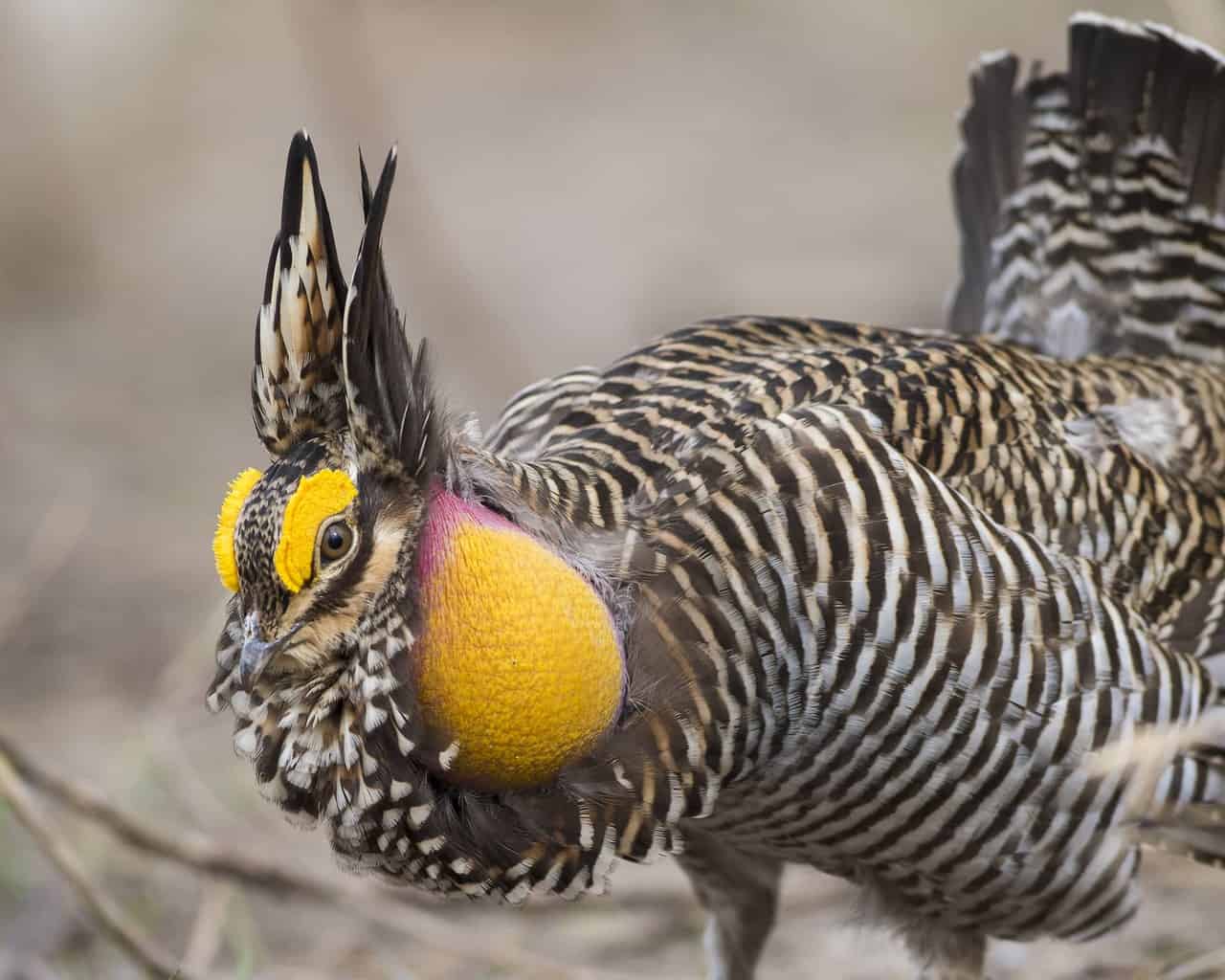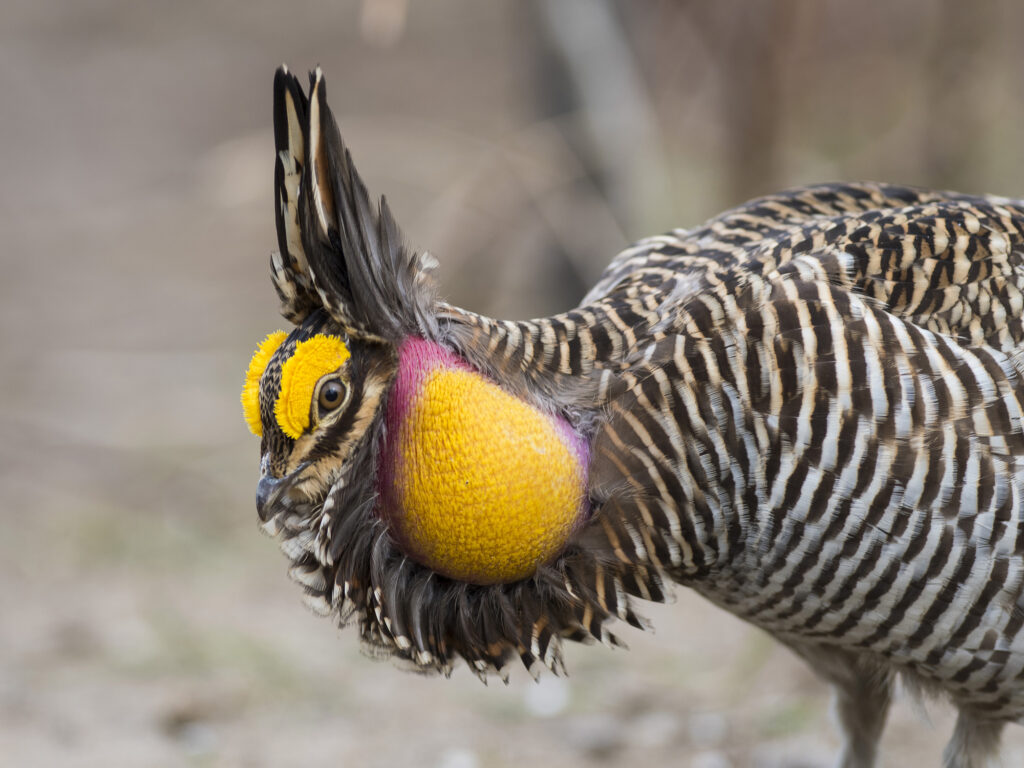If you are lucky enough to be visiting the prairies of North Dakota, South Dakota, Nebraska, and Kansas between February and April, you may get to see the mating dance of the Greater Prairie-Chicken!
If you do, here’s what you’ll see:
The male Prairie-Chickens will gather together in one area (called a “lek”), but still defend their own small zone of territory while in the group. Then, they will perform a complicated mating dance.
They lower their heads, raise their tufted neck feathers, point their tail forward, and inflate the bright orange air sacs on their necks. They bow downward and shake their wings, which are outstretched toward the ground. Their dance continues with foot stomping and tail clicking.
What a show!
But it’s not over–those inflating air sacs also create a booming vocalization to show off to potential mates.
Males dance and perform, then fight one another to protect their little circle of territory.
Upon the arrival of the females, things get even more exciting. Males “flutter jump” into the air while flapping their wings.
When a female chooses a mate, she droops her wings and may also flutter jump toward him. She will prioritize older, more experienced males to mate with. Specifically, she watches for large eye combs, long legs, and the best position within the group.
What Do Greater Prairie-Chickens Look Like?
The Prairie-Chicken is pretty fascinating in appearance. It is somewhat similar to the Greater Sage-Grouse, but the Sage-Grouse has air sacs on the breasts instead of on the sides of the neck.
It is crow-sized and from above, it has a mottled appearance in rufous, black, brown, and white. Underneath, it is barred in brown and white.
It has a rounded body and short legs, plus a short tail and a ruff of feathers around its neck. When the male inflates his air sacs, he raises these feathers, giving the appearance of tall ears or horns.
Aren’t Prarie-Chickens Extinct?

A close relative of the Praire-Chicken, the Heath Hen, is extinct.
However, there are two surviving types of Greater Prairie-Chickens: The Attwater’s Prairie-Chicken and the Greater-Prairie Chicken.
The Greater Prairie-Chicken is larger than the Attwater Prairie-Chicken and is identified by its bare lower legs.
What Do Greater Prairie-Chickens Eat?
Greater Prairie-Chickens have a varied diet that includes leaves, seeds, fruits, and buds, as well as grains: corn, sunflower, sorghum, and soy.
They also eat insects, including crickets, beetles, and grasshoppers. Attwater’s Prairie-Chickens have a similar diet but without grains.
They are foragers, although they will sometimes fly into trees for certain leaves and flower buds. They are more likely to fly into a tree in the winter when the snow covers much of the forageable food on the ground.
When they are chicks, Greater Prairie-Chickens have a diet that consists mostly of small insects.
Habitat & Nesting Behaviors of the Greater Prairie-Chicken:
You can guess the preferred habitat of Greater Prairie-Chickens from their name: they inhabit prairies!
There are several different kinds of prairies, including shortgrass, mixed-grass, and tallgrass. They are less likely to be found in shortgrass prairies.
They need lots of dense brush to hide from predators and natural elements. They also need an area where there are plentiful bugs and insects so that their chicks have a good food source.
Prairie-Chickens are susceptible to both land and air predators. Land predators include snakes, coyotes, raccoons, skunks, badgers, and ground squirrels.
Meanwhile, the threat from the air includes red-tailed hawks, great horned owls, northern goshawks, and northern harriers.
The world is a scary place for the Greater Prairie-Chicken, who has little in the form of defense mechanisms. They are good at camouflage, however, and will hide themselves (and their babies) in the dense brush.
How Long Do Prairie-Chickens Live?
Greater Prairie-Chickens usually live about 2-3 years in the wild.
Conservation Efforts
The Greater Prairie-Chicken saw a significant decline in population between the 19th and 20th centuries.
According to conservationists, their numbers have been mostly stable since 1966. They are a species of high concern (Red Watch List and Vulnerable on the IUCN Red List of Threatened Species), but they are also doing well enough that they can be legally hunted.
However, the Attwater’s Prairie-Chicken is at severe risk of extinction.

